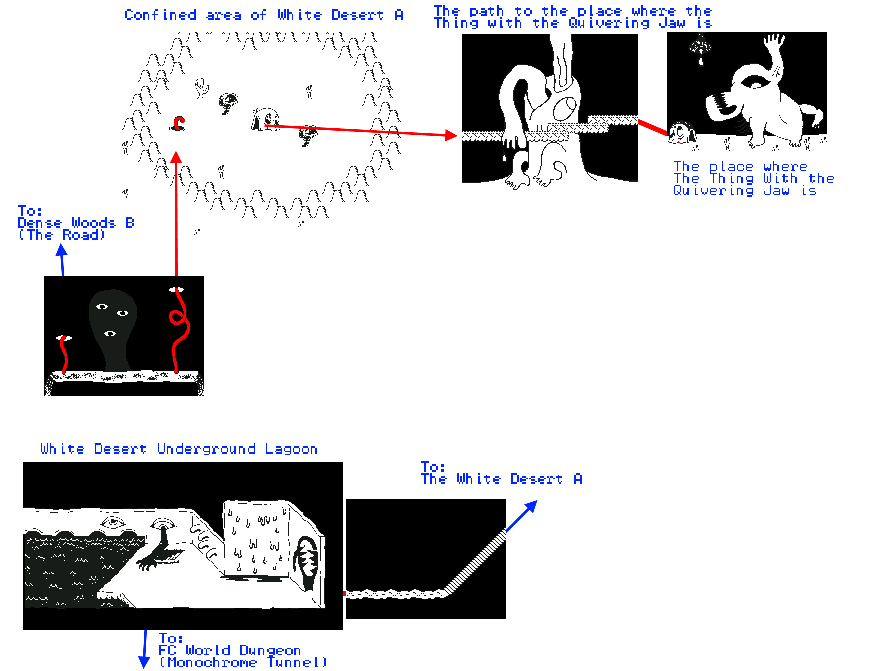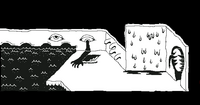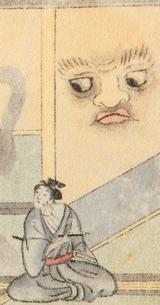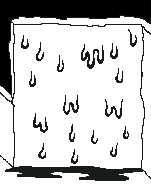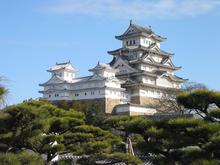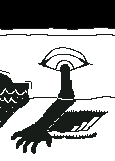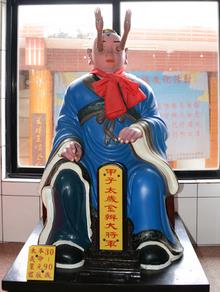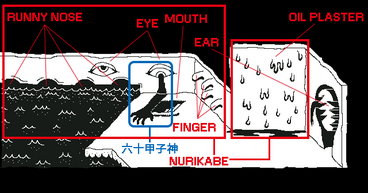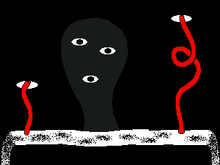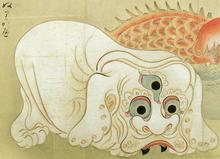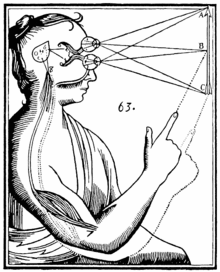>Mt.kiki No edit summary |
>Mt.kiki No edit summary |
||
| Line 89: | Line 89: | ||
----2007年(平成19年)8月、川崎市市民ミュージアムの学芸室長・湯本豪一(当時)の所有する妖怪絵巻『'''化物づくし絵巻'''』(奥書には1802年(享和2年)に南部藩の御用絵師・狩野由信が室町時代の絵などを参考に制作したものとある)に収録されている妖怪画のひとつが、「塗壁」を描いたものとして発表された。 | ----2007年(平成19年)8月、川崎市市民ミュージアムの学芸室長・湯本豪一(当時)の所有する妖怪絵巻『'''化物づくし絵巻'''』(奥書には1802年(享和2年)に南部藩の御用絵師・狩野由信が室町時代の絵などを参考に制作したものとある)に収録されている妖怪画のひとつが、「塗壁」を描いたものとして発表された。 | ||
[[File:Torin Nukaribe.jpg|thumb|220x220px|A depiction of the nurikabe]] | [[File:Torin Nukaribe.jpg|thumb|220x220px|A depiction of the nurikabe]] | ||
本来この妖怪画は絵のみで名前が記されておらず、何を描いたものか不明であったが、2007年(平成19年)1月、アメリカ合衆国のユタ州にあるブリガムヤング大学のハロルド・B・リー図書館に寄贈されている妖怪画(L・トミー・ペリー・コレクションの一つ。画像参照)と一致し、後者に「'''ぬりかべ'''」と名称が記載されていたことから名称が判明した。この「ぬりかべ」の絵は、どちらも3つ目の獅子か犬のような姿の妖怪が描かれている<sup>[24][23][6]</sup>。 | 本来この妖怪画は絵のみで名前が記されておらず、何を描いたものか不明であったが、2007年(平成19年)1月、アメリカ合衆国のユタ州にあるブリガムヤング大学のハロルド・B・リー図書館に寄贈されている妖怪画(L・トミー・ペリー・コレクションの一つ。画像参照)と一致し、後者に「'''ぬりかべ'''」と名称が記載されていたことから名称が判明した。この「ぬりかべ」の絵は、どちらも3つ目の獅子か犬のような姿の妖怪が描かれている<sup>[https://ja.wikipedia.org/wiki/%E5%A1%97%E5%A3%81#cite_note-24 <nowiki>[24]</nowiki>][https://ja.wikipedia.org/wiki/%E5%A1%97%E5%A3%81#cite_note-23 <nowiki>[23]</nowiki>][https://ja.wikipedia.org/wiki/%E5%A1%97%E5%A3%81#cite_note-6 <nowiki>[6]</nowiki>]</sup>。 | ||
Originally this ''[https://en.wikipedia.org/wiki/Y%C5%8Dkai Yōkai]'' picture was only a picture with no name and it was unknown what was drawn, but in January 2007, at the Brigham Young University in Utah, USA, Harold B. · It coincided with the ''[https://en.wikipedia.org/wiki/Y%C5%8Dkai Yōkai]'' picture donated to Lee Library (see L. Tommy · Perry · Collection, see picture), and the name was found because the name was written "[https://ja.wikipedia.org/wiki/%E5%A1%97%E5%A3%81 Nurikabe]" in the latter. The drawing of this "[https://ja.wikipedia.org/wiki/%E5%A1%97%E5%A3%81 Nurikabe]" is drawn by a third lion or a dog-like ''[https://en.wikipedia.org/wiki/Y%C5%8Dkai Yōkai]'' [https://ja.wikipedia.org/wiki/%E5%A1%97%E5%A3%81#cite_note-24 <nowiki>[24]</nowiki>] [https://ja.wikipedia.org/wiki/%E5%A1%97%E5%A3%81#cite_note-nurikabesugata-23 <nowiki>[23]</nowiki>] [https://ja.wikipedia.org/wiki/%E5%A1%97%E5%A3%81#cite_note-%E4%BA%AC%E6%A5%B5%E4%BB%96-6 <nowiki>[6]</nowiki>]. | Originally this ''[https://en.wikipedia.org/wiki/Y%C5%8Dkai Yōkai]'' picture was only a picture with no name and it was unknown what was drawn, but in January 2007, at the Brigham Young University in Utah, USA, Harold B. · It coincided with the ''[https://en.wikipedia.org/wiki/Y%C5%8Dkai Yōkai]'' picture donated to Lee Library (see L. Tommy · Perry · Collection, see picture), and the name was found because the name was written "[https://ja.wikipedia.org/wiki/%E5%A1%97%E5%A3%81 Nurikabe]" in the latter. The drawing of this "[https://ja.wikipedia.org/wiki/%E5%A1%97%E5%A3%81 Nurikabe]" is drawn by a third lion or a dog-like ''[https://en.wikipedia.org/wiki/Y%C5%8Dkai Yōkai]'' [https://ja.wikipedia.org/wiki/%E5%A1%97%E5%A3%81#cite_note-24 <nowiki>[24]</nowiki>] [https://ja.wikipedia.org/wiki/%E5%A1%97%E5%A3%81#cite_note-nurikabesugata-23 <nowiki>[23]</nowiki>] [https://ja.wikipedia.org/wiki/%E5%A1%97%E5%A3%81#cite_note-%E4%BA%AC%E6%A5%B5%E4%BB%96-6 <nowiki>[6]</nowiki>]. | ||
| Line 100: | Line 100: | ||
----The notion of a "[https://en.wikipedia.org/wiki/Pineal_gland#Society_and_culture Pineal-Eye]" is central to the philosophy of the French writer [https://en.wikipedia.org/wiki/Georges_Bataille Georges Bataille], which is analyzed at length by literary scholar Denis Hollier in his study ''Against Architecture''. In this work Hollier discusses how Bataille uses the concept of a "[https://en.wikipedia.org/wiki/Pineal_gland#Society_and_culture Pineal-Eye]" as a reference to a blind-spot in Western rationality, and an organ of excess and delirium.<sup>[https://en.wikipedia.org/wiki/Pineal_gland#cite_note-60 <nowiki>[60]</nowiki>]</sup> This conceptual device is explicit in his surrealist texts, ''The Jesuve'' and ''The [https://en.wikipedia.org/wiki/Pineal_gland#Society_and_culture Pineal-Eye]''.<sup>[https://en.wikipedia.org/wiki/Pineal_gland#cite_note-61 <nowiki>[61]</nowiki>]</sup> | ----The notion of a "[https://en.wikipedia.org/wiki/Pineal_gland#Society_and_culture Pineal-Eye]" is central to the philosophy of the French writer [https://en.wikipedia.org/wiki/Georges_Bataille Georges Bataille], which is analyzed at length by literary scholar Denis Hollier in his study ''Against Architecture''. In this work Hollier discusses how Bataille uses the concept of a "[https://en.wikipedia.org/wiki/Pineal_gland#Society_and_culture Pineal-Eye]" as a reference to a blind-spot in Western rationality, and an organ of excess and delirium.<sup>[https://en.wikipedia.org/wiki/Pineal_gland#cite_note-60 <nowiki>[60]</nowiki>]</sup> This conceptual device is explicit in his surrealist texts, ''The Jesuve'' and ''The [https://en.wikipedia.org/wiki/Pineal_gland#Society_and_culture Pineal-Eye]''.<sup>[https://en.wikipedia.org/wiki/Pineal_gland#cite_note-61 <nowiki>[61]</nowiki>]</sup> | ||
[[File:Descartes mind and body.gif|thumb|272x272px]] | [[File:Descartes mind and body.gif|thumb|272x272px]] | ||
In the late 19th century [https://en.wikipedia.org/wiki/Helena_Blavatsky Madame Blavatsky] (who founded [https://en.wikipedia.org/wiki/Theosophy theosophy]) identified the pineal gland with the Hindu concept of the [https://en.wikipedia.org/wiki/Third_eye third eye], or the [https://en.wikipedia.org/wiki/Ajna Ajna chakra]. This association is still popular today.<sup>[7]</sup> | In the late 19th century [https://en.wikipedia.org/wiki/Helena_Blavatsky Madame Blavatsky] (who founded [https://en.wikipedia.org/wiki/Theosophy theosophy]) identified the pineal gland with the Hindu concept of the [https://en.wikipedia.org/wiki/Third_eye third eye], or the [https://en.wikipedia.org/wiki/Ajna Ajna chakra]. This association is still popular today.<sup>[https://en.wikipedia.org/wiki/Pineal_gland#cite_note-plato.stanford.edu-7 <nowiki>[7]</nowiki>]</sup> | ||
松果体は、[https://ja.wikipedia.org/wiki/%E3%83%A8%E3%83%BC%E3%82%AC ヨーガ]における6番目の[https://ja.wikipedia.org/wiki/%E3%83%81%E3%83%A3%E3%82%AF%E3%83%A9 チャクラ](アージュニャーまたは[https://en.wikipedia.org/wiki/Third_eye 第3の目])、または[https://en.wikipedia.org/wiki/Ajna 7番目のチャクラ](サハスラーラ)と結び付けられることもある。松果体は眠っている器官であり、目覚めると[https://ja.wikipedia.org/wiki/%E3%83%86%E3%83%AC%E3%83%91%E3%82%B7%E3%83%BC テレパシー]が使えるようになると信じる人もいる。 | 松果体は、[https://ja.wikipedia.org/wiki/%E3%83%A8%E3%83%BC%E3%82%AC ヨーガ]における6番目の[https://ja.wikipedia.org/wiki/%E3%83%81%E3%83%A3%E3%82%AF%E3%83%A9 チャクラ](アージュニャーまたは[https://en.wikipedia.org/wiki/Third_eye 第3の目])、または[https://en.wikipedia.org/wiki/Ajna 7番目のチャクラ](サハスラーラ)と結び付けられることもある。松果体は眠っている器官であり、目覚めると[https://ja.wikipedia.org/wiki/%E3%83%86%E3%83%AC%E3%83%91%E3%82%B7%E3%83%BC テレパシー]が使えるようになると信じる人もいる。 | ||
Revision as of 15:40, 2 February 2018
White Desert Underground Lagoon (Nurikabe )
The nurikabe (ぬりかべ) is a Yōkai, or spirit, from Japanese folklore.
It manifests as a wall that impedes or misdirects walking travelers at night. Trying to go around is futile as it extends itself forever. Knocking on the lower left part of the wall makes it disappear.[1] It has been suggested that the legend was created to explain travellers losing their bearings on long journeys.[2]
江戸時代の妖怪譚『稲生物怪録』の諸本に描かれている絵の中には、家の壁に目と口が現れて人を睨むという怪異の絵が描かれている。狩野由信の妖怪画などの発見される前は、この怪異を塗壁の祖形なのではないかとする仮説もあった。
White Desert Underground Lagoon (Oil Plaster)
妖怪研究家・山口敏太郎はあくまで自身の推理とした上で、「カベヌリ」の発祥地である臼杵市が漆喰壁の技術に長けた町であることに着目し、塗壁の伝承は江戸時代中期の食料事情の変化と、塗壁の伝承地でかつて発明された油漆喰(撥水加工された壁)の普及に関係しているという説を唱えている。
Yōkai researcher, Yoshida Toshitaro took it as an inference of itself and focused on the fact that Usuki city, the birthplace of "Nurikabe", was a town familiar to the technology of plaster walls, and the lore of painted walls was the Edo period It advocates the theory that it relates to the change of the food situation in the middle term and the diffusion of the Oil Plaster invented (water repellent processed wall) in the traditional place of the painted wall.
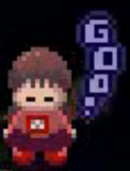
White Desert Underground Lagoon (Thiamine deficiency)
それによれば、人々の口にする米が玄米から白米に替わったことでビタミン不足が起き、ビタミンAの欠乏による夜盲症が目に見えない壁があるかのような感覚を、ビタミンB1の欠乏による脚気が足を前に進ませることのできないような感覚をもたらし、そうした行き止まりの怪異のような身体状態に、油漆喰が水を弾くイメージが加えられて「塗壁」という妖怪が誕生した、との説を示している[10]。
According to it, a sense of vitamin B1 deficiency due to deficiency of vitamin A, a feeling as if there is an invisible wall in Nyctalopia due to deficiency of vitamin A, due to the fact that the rice which people make mouth changes from brown rice to white rice occurs Beriberi brings a sense that makes it impossible to let the foot advance, and the image of the oil plaster being added to the water is added to the physical condition like a dead end such a dead, and a Yōkai called "Nurikabe" was born. The theory of [10] .
※Madotsuki can see the appearance of Yōkai(Nurikabe).⇒ Madotsuki 's Health condition may have been bad(Thiamine deficiency).
White Desert Underground Lagoon (God of Holz-Ratte 60-Jahre-Zyklus)
六十甲子神,六十甲子神,古稱歲神,又稱太歲,六十元辰。職能:值年太歲,掌握本歲的人間禍福,他們「率領各神,統正方位,斡運時序,總歲成功」。六十甲子是中華民族最早、最大的發明創造。六十甲子最古老的用途是紀年、紀月、紀日、紀時。紀年為60年一個周期,紀月為5年一個周期,紀日為60天一個周期,紀時為5天一個周期。
Das Jahr der Holz-Ratte (Jiazi, chinesisch 甲子, Pinyin jiǎzǐ) ist das 1. Jahr im 60-Jahre-Zyklus (天支) des chinesischen Kalenders. Dies ist in der chinesischen Astrologie ein solches Mondjahr, das durch eine Verbindung des ersten Himmelsstammes (甲, jiǎ, Element Holz und Yáng) mit dem ersten Erdzweig(子, zǐ), symbolisiert durch die Ratte (鼠, shǔ), charakterisiert ist.
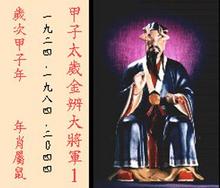
「甲子」というのは、十天干の甲、乙、丙、丁、戊、己、庚、辛、壬、癸、十二地支の子、丑、寅、卯、辰、己、午、未、申、酉、戌、亥を組み合わせてできる60通りの年の数え方です。
この60年には、毎年、担当する神がいます。この神を「太歳神(六十甲子神)」といいます。
甲子太歳金辨大将軍とは甲子の歳を担当する太歳神の一人、金辨大将軍という意味です。
甲子太歳金辨大将軍(God of Holz-Ratte 60-Jahre-Zyklus) is one of the grand-old gods who are responsible for the age of Holz-Ratte, meaning "金辨(Kim Byeon) of Major-General and God of Holz-Ratte 60-Jahre-Zyklus(六十甲子神)".
↓
目から手が出ている理由は、明代の小説『封神演義』等による民間で作られ語られた道教系の神様の影響だといわれています。 『封神演義』には楊任という神様が出てきます。 楊任(六十甲子神)は商(殷)の紂王に仕えていましたが、紂王の腐敗、堕落を諫言したために、目をえぐられてしまいました。 それを哀れに思った道徳真君が楊任(六十甲子神)の目に仙丹を入れました。 すると、目から手が生えて、手に目玉ができました(眼中有手,手中有眼)。 これは手が届くところなら何でもどこでも見ることができる、という神技を具現化したものです。
It is said that the reason why hands come out of the eyes is the influence of the Taoist gods made and spoken by the private sector such as the Folk Dynasty novel "封神演義". God that is called 楊任(六十甲子神) comes out in "封神演義". 楊任(六十甲子神) was serving the king of the 商 (殷), but because he declared Corruption and corruption of the King, he was scolded. 道徳真君(Xian) who thought it pathetic put 仙丹(Medicine) in the eyes of 楊任(六十甲子神). Then, hands grew from the eyes and the eyeballs were made in hand (眼中有手,手中有眼 = hands in the eyes, hands with eyes). This embodies the god skill that he can see anything anywhere he can reach.
White Desert Underground Lagoon (Taoist Temple)
A Taoist temple (traditional Chinese: 觀; simplified Chinese: 观; pinyin: guān, also 道观 dàoguān, literally "[place] where the Tao is observed/cultivated") is a place of worship in Taoism.
Structure and function can vary according to the Taoist school the temple belongs to. For example, guān of the Quanzhen School are monasteries where celibate daoshi live.
※"White Desert Underground Lagoon" is an object related to "Taoism".⇒ Because it is different from "Buddhism", it seems that it is divided into rooms away from "The White Desert A"
Dense Woods B (Nurikabe)
2007年(平成19年)8月、川崎市市民ミュージアムの学芸室長・湯本豪一(当時)の所有する妖怪絵巻『化物づくし絵巻』(奥書には1802年(享和2年)に南部藩の御用絵師・狩野由信が室町時代の絵などを参考に制作したものとある)に収録されている妖怪画のひとつが、「塗壁」を描いたものとして発表された。
本来この妖怪画は絵のみで名前が記されておらず、何を描いたものか不明であったが、2007年(平成19年)1月、アメリカ合衆国のユタ州にあるブリガムヤング大学のハロルド・B・リー図書館に寄贈されている妖怪画(L・トミー・ペリー・コレクションの一つ。画像参照)と一致し、後者に「ぬりかべ」と名称が記載されていたことから名称が判明した。この「ぬりかべ」の絵は、どちらも3つ目の獅子か犬のような姿の妖怪が描かれている[24][23][6]。
Originally this Yōkai picture was only a picture with no name and it was unknown what was drawn, but in January 2007, at the Brigham Young University in Utah, USA, Harold B. · It coincided with the Yōkai picture donated to Lee Library (see L. Tommy · Perry · Collection, see picture), and the name was found because the name was written "Nurikabe" in the latter. The drawing of this "Nurikabe" is drawn by a third lion or a dog-like Yōkai [24] [23] [6].
※Objects of Dense Woods B and White Desert Underground Lagoon have an association of "Nurikabe"
Dense Woods B (Pineal-Eye)
The notion of a "Pineal-Eye" is central to the philosophy of the French writer Georges Bataille, which is analyzed at length by literary scholar Denis Hollier in his study Against Architecture. In this work Hollier discusses how Bataille uses the concept of a "Pineal-Eye" as a reference to a blind-spot in Western rationality, and an organ of excess and delirium.[60] This conceptual device is explicit in his surrealist texts, The Jesuve and The Pineal-Eye.[61]
In the late 19th century Madame Blavatsky (who founded theosophy) identified the pineal gland with the Hindu concept of the third eye, or the Ajna chakra. This association is still popular today.[7]
松果体は、ヨーガにおける6番目のチャクラ(アージュニャーまたは第3の目)、または7番目のチャクラ(サハスラーラ)と結び付けられることもある。松果体は眠っている器官であり、目覚めるとテレパシーが使えるようになると信じる人もいる。

